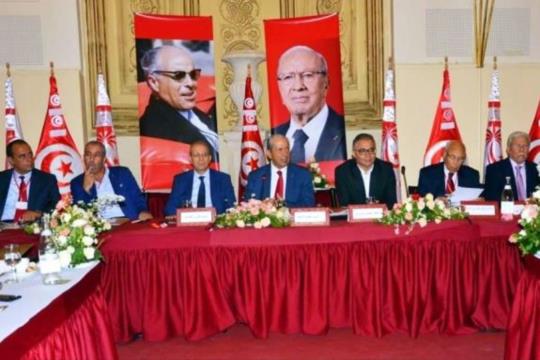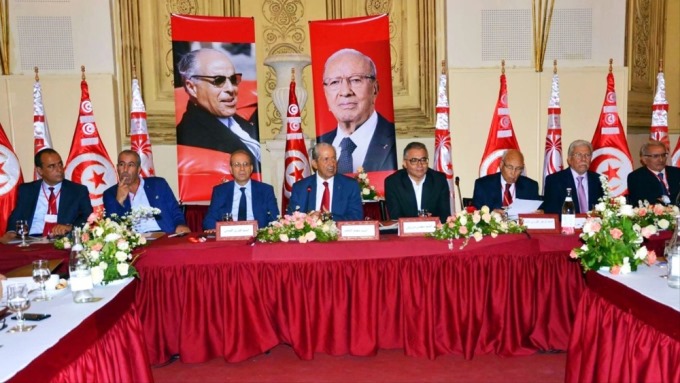
 |
| Tunisia's Nidaa Tounes continues to splinter, with implications for both the party and the state [AlJazeera] |
| Abstract Nidaa Tounes, a party born post-Tunisian revolution, is currently experiencing internal rifts, which in turn is having an impact on the country’s secular-Islamist ruling government’s ability to move forward. This rift became especially obvious after the party’s founder and leader, Beji Caid Essebsi, won the presidency and consequently resigned as party leader according to Tunisia’s constitutional law. This position paper examines key actors and roots of the party’s rift, how this rift has impacted state institutions and future scenarios for the governing coalition. |
Introduction
The Nidaa Tounes crisis that came to light after President Beji Caid Essebsi’s resignation from the party took a new turn after terror attacks that completely rearranged Tunisia’s national priorities. The 24 November attack on a bus carrying elite presidential guard forces through the Tunisian capital delayed the national address Essebsi was scheduled to give that day, addressing the party’s crisis. It can be said the party’s rift is one of the symptoms of the conflicts within the party and that this conflict over power has extrapolated to the state. The current government has been in place for nearly ten months now and brought together several parties, including remnants of the old regime which joined Nidaa Tounes and the Islamist Ennahda party. While this coalition was an achievement, it also illustrated how leftists within Nidaa Tounes continued their sharp rhetoric against the Islamists, something former Democratic Constitutional Rally (RCD) party members frowned upon after they formed Nidaa Tounes and went on to contest parliamentary and presidential elections. This position paper examines key actors and roots of the party’s rift, how this rift has impacted state institutions and future scenarios for the governing coalition.
Nidaa Tounes’ crisis: roots and players
To assume that the Nidaa Tounes party is experiencing a rift simply because of Beji Caid Essebsi’s constitutionally-mandated resignation is an oversimplification of the crisis. One of the key roots of the rift within Nidaa Tounes is that its very origins were built on challenging the Troika government that was elected in October 2011. When Nidaa Tounes was formed, it attracted influential businessmen who had previously held leading positions in Ben Ali’s RCD (which was dissolved by court order immediately after the revolution). It also attracted leftists whose priority was challenging not only the Troika in general, but also the Islamists in specific. For the leftists, it was only logical that once the party they helped establish won, they would seek a return on their investment and further attempt to alienate the Islamists as well as seek leadership positions in the government (despite the fact that they are small in number). That did not sit well with other members of the party who knew that refusing to work with the Islamists would result in a no-confidence vote as well as delay the formation of a government even further.
Another common explanation of the rift is that it is due to a difference of opinion between the party’s former Secretary General, Mohsen Marzouk (who has a leftist past) and the son of the president, Hafith Caid Essebsi; however, again, that alone does not explain the rift. While the former wishes to direct energy at the party’s next convention to internal elections, the latter wants to preserve the current structure and positions, particularly given that the structural affairs within the party have been his responsibility for quite a while. Marzouk’s resignation as the party’s secretary general came as no surprise, for it is a symptom of growing discord within, and could be a segue to his resignation from the entire party.
Impact of the party’s problems on state institutions
While the President has purported he is neutral on his former party’s rift, the reality is that the national address he gave 29 November (which was delayed due to the presidential guard attack) was clearly in favour of his son’s vision for the party and for the country. In other words, rather than assure constituents that he would distance himself from party politics in his capacity as president, his speech gave the indication that despite his constitutionally-mandated resignation, the country’s political health could be sacrificed for the party’s survival.
Furthermore, Nidaa’s leftists were assigned very few seats in the government and are a very small percentage overall, thus they are overwhelmed by the party’s RCD-loyalists. This has had a definite impact on state institutions – the government was already struggling, and the rifts in the party have only made it more difficult for the government to undergo initiatives addressing the economic, social and security problems in the country. This is especially true given Essebsi’s failed push in the parliament for legislation that would pardon businessmen involved in corruption with Bin Ali’s regime.
Coalition government scenarios
The current coalition has withstood ten months, but the reality is that its makeup will change given the current political climate in the country. It is likely that Afaq Tounes will leave, and that Nidaa Tounes’ makeup will change significantly. This is illustrated in Marzouk’s recent resignation and could signal his intention to leave not only his post as Secretary General, but also the party in general. Other leftist-leaning members of the party have already submitted their resignations, a clear indication that Nidaa Tounes is heading towards birthing a splinter party.
In turn, this would mean that Nidaa Tounes’ RCD camp would work more closely with Ennahda, and that the latter’s share in the coalition would increase. While this is positive for Ennahda, it will mean more criticism towards the coalition in general from opposition members to both parties. There is a possibility that early elections may be held, but this would be a big risk for both Nidaa Tounes and Ennahda. However, should Nidaa Tounes continue to splinter, this could be a possibility.
Conclusion
In addition to a crisis within Nidaa Tounes, it can be said the country is facing a leadership crisis. Recently, about fifty of the country’s elites (who overwhelmingly ascribe to an extreme left ideology) issued a statement in Almaghreb newspaper, expressing their lack of confidence in Nidaa Tounes and its policies, calling for a new party structure that would completely cut ties with the Islamists, which is in line with Marzouk’s line of thinking.
*This is a condensed version of the Arabic position paper published here: http://studies.aljazeera.net/positionestimate/2015/12/201512812424263315.htm
_______________________________________________________
Copyright © 2015 Al Jazeera Center for Studies, All rights reserved.